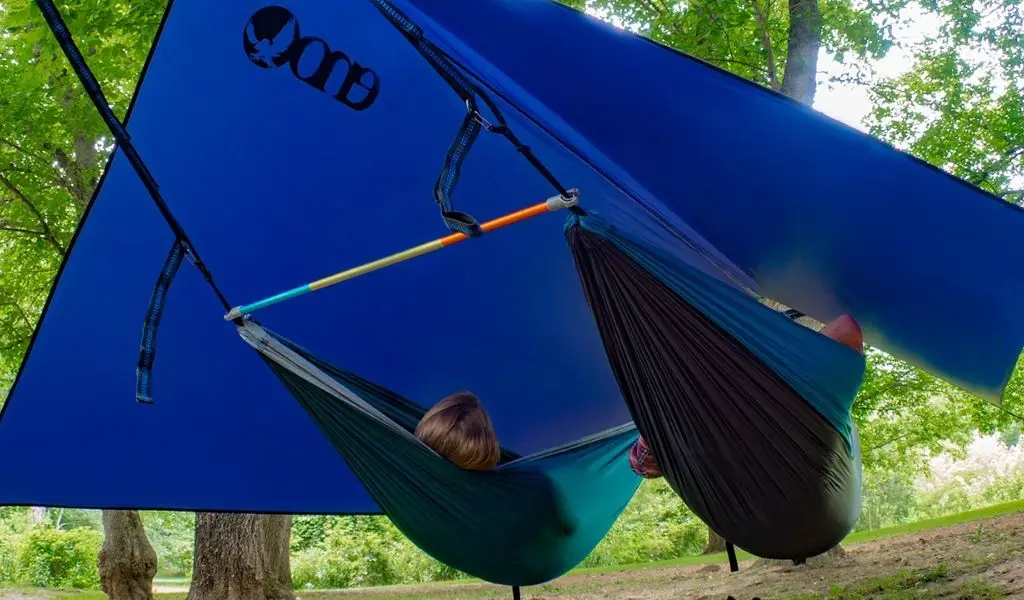Disclaimer: As an affiliate I may earn a commission on any qualifying purchases, including those from Amazon.com, at no extra cost to you – read more.
If you’re heading out camping with a partner and opting for a hammock instead of a tent, chances are you’ll be wondering if it’s possible to share a hammock?
Yes, two people can share a hammock provided it’s wide enough and you’re not over the weight capacity. However, sleeping overnight in a hammock is not recommended with more than one person because you’ll be pressed together making it hard to find a comfortable sleeping position.
An alternative to sharing a hammock is to use a tandem bar, this allows you to arrange two hammocks side-by-side from the same tree. You’ll achieve many of the same advantages of sharing a hammock whilst still getting a good night’s sleep.
In this guide, I’ll run through all of the pros and cons of sharing one hammock between two people and further information about using a tandem bar instead.
Can Two People Share a Hammock?
Yes, two people can share a hammock, double-sized hammocks are designed for this person. It can be great to lounge in a hammock with your partner and maybe even take a short nap.
But, when it comes to getting a good night’s sleep, I wouldn’t advise that you attempt to share a hammock as it will be very hard to find a sleeping arrangement that both people are happy with for an entire night.
Here are the pros and cons of sharing a hammock:
| Pros | Cons |
| 1. Warmth from shared body heat. | 1. You’ll be pressed together. |
| 2. Save on gear weight. | 2. Getting up in the night is a pain. |
| 3. The romantic element. | 3. Top quilts are not designed for two people. |
| 4. Ideal for lounging. | 4. Hard to maintain a comfortable temperature for both people. |
Below is more detail about why I’ve mentioned each of these things.
Pros:
Let’s being by taking a look at each of the pros of sharing a hammock:
If you’re camping in colder climates, there is a warmth benefit to sharing a hammock rather than sleeping individually.
Snuggling together is a proven way to stay warm, not only will you minimize convection heat loss as you are reducing the surface area of your bodies, but you will both be heating the air under the insulation.
Snuggling nude is usually considered the most effective way to share body heat (source) but in my personal experience camping in hammocks, it has been warmer with clothes on for extra insulation and you don’t have to strip off before you get in.
Warmth could also be seen as a con, depending upon where you’re camping. If you’re in a warmer environment, you could end up being too hot. At this point, there’s not much you can do.
One of the main reasons why people decide to share a hammock is to save on carrying weight of the hammock camping gear. Every lb makes a difference when you’re backpacking or carrying your gear a long way each day.
The savings from the hammock itself are minimal, but the associated gear like underquilts and top quilts for keeping warm add to the saving.
Here is an estimate of the weight savings from sharing a hammock:
| Double hammock instead of two singles: | -1lb |
| One less underquilt: | -2lbs |
| One Blanket instead of two top quilts | -2lbs |
| Tarps and accessories: | You can still share these (see the tandem bar below) – no weight saving |
| Total weight difference: | -5lbs |
*these are calculated using ENO camping hammocks and OneTigris insulation which I rated as the best underquilts for ENO.
As you can see, there’s an approximate weight saving of 5lbs from sharing a hammock which equates to 2.5lbs per person.
If you’re planning to share your hammock with your partner (being that close it’s the only partner I would personally consider), there can be a romantic element to cuddling up under the stars.
I have no problems at all with cuddling in a hammock, or even taking things a bit further. But, when it comes to sleeping, it can be tough to find a position that suits both people.
Hammocks aren’t just for sleeping in a night, they are great for taking naps or just generally lounging around during the day, whether at home or out on the trail.
Two people can happily lounge around in a hammock. This can be lying down as you’d typically enjoy a hammock or in a more upright position by lying across the width of the hammock (like the first image in this article).
Cons:
Now lets take a more detailed look at the cons of sharing a hammock so you can see why I don’t recommend it for overnight sleeping:
The center of gravity of a hammock is right down the center, when you’re hammocking by yourself, this is not a problem.
When two people share a hammock, the extra weight accentuates the sag down the center. You’ll both be pressed together which can be uncomfortable for an entire night.
If you do somehow manage to get a decent sleep, this will quickly be disturbed if your partner needs to get up in the night for the toilet.
There’s no way that one person can leave the hammock and get back in without completely waking up the other person. Now, you’ll have to start all over again trying to get back to sleep.
If you’re using the proper camping gear, you’ll likely opt for a top quilt over a sleeping bag. The problem with this is that top quilts are designed for one person.
There is usually a foot box area that keeps your toes nice and toasty. I can’t fathom a way this can be shared.
If you are sleeping in individual sleeping bags, you are foregoing many of the benefits of sharing a hammock as you are still packing all the extra gear, you’re not sharing body heat, and you can’t cuddle.
The only real option is an actual camping blanket without the foot box for insulation. These are not as effective as sleeping bags or top quilts, and if you’re sharing with a blanket hog that’s a whole different matter in a hammock.
If you’re sharing with a partner who likes to sleep at a different temperature to you, this can be very difficult in a hammock.
It’s not uncommon for men to get hotter than women at night due to extra muscle mass (source), this is easy to control in a double bed as you can maintain distance to have a separate micro-climate and you can easily roll out from the duvet if you get too hot.
Sharing a hammock, it’s a different story. You are so tightly pressed together that you will share the same microclimate and the insulation is all or nothing.
Are Bridge Hammocks Good for Two People?
The pros and cons above assumed you’ll be sleeping in a traditional gathered-end camping hammock. But an alternative type of hammock that’s also popular with campers is a bridge hammock.
These have spreader bars at each end to give an open design that’s more similar to a proper bed.
Whilst there is still a center of gravity down the middle, it’s not as profound as a gathered end style hammock so you’re not pressed together as much making it easier to find a comfortable position with two people.
The problem you’ll encounter with a bridge hammock is that they are designed for one person. I’ve not yet found a bridge hammock that’s wide enough for two people.
Bridge hammocks are not that great for backpackers or hikers because the spreader bars add extra weight and take up a lot more room than a gathered end hammock.
Summary: A bridge hammock is slightly better than a gathered end hammock for sharing, but it is still better to sleep separately with a tandem bar (see below).
How to Hammock with a Partner at Night
So, all things considered, sharing one hammock between two people isn’t such a great idea if getting a peaceful sleep is on top of your agenda.
But, that doesn’t mean you can’t reap some of the advantages shared above. The best way to hammock camp with a partner is using a tandem bar as shown here.
This allows you to set up two hammocks from the same tree and hang nice and close to each other so you get that shared experience.

With side-by-side hammocks, you can share straps and a tarp so you’ll still benefit from a reduced gear load. Since the tarp and stakes are usually the heavier pieces of gear, this is a massive benefit.
However, if you’re camping in the cold, you’ll still need separate underquilts for Winter.
What’s the Best Tandem Bar?

The ENO Fuse Tandem System is the best tandem bar for hammocks.
When in use, they are 31” wide, however, they easily fold down into three sections so you can fit them snuggly in your bag. At 9.8oz, they’re also the most lightweight tandem bars I found as they are made from aluminum alloy.
The bars attach to the rings on each end of your hammock to keep them neatly spread apart. They are designed to perfectly fit ENO hammocks but would be suitable for use with any camping hammock.
Alternative Idea: Bunk Hammocks
If you’re feeling brave (or just don’t have a tandem bar to hand), an alternative is to try bunk hammocks.
Rather than hanging your hammocks side-by-side, you’ll hang them one above the other. This allows you to share a tarp and you’ll also feel much closer together than using separate trees.
In reality, this is a bit of fun and particularly appeals to kids. But, it’s not as practical as the tandem bar because the top person will have to deal with lots of wind chill, whilst the bottom person won’t have sufficient protection against side rain due to the placement of the tarp.
I would only recommend attempting this if you’re competent at hanging a hammock, the last thing you want is the top person falling on the bottom person.


